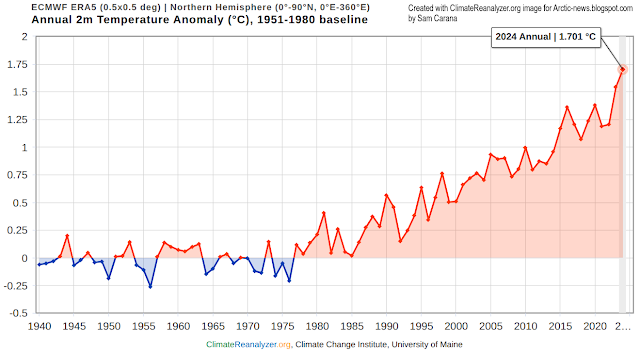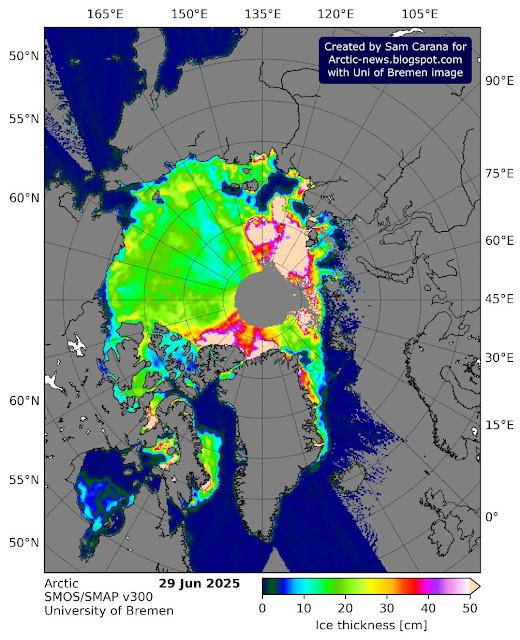Arctic sea ice extent was 8.35 million km² on July 4, 2025, a record low extent for this time of year. This record daily low extent is the more significant since it was reached in the absence of El Niño conditions. Instead, ENSO-neutral and borderline La Niña conditions are currently dominant.
Sea ice extent is one out of several measurements indicating the miserable state the Arctic sea ice is in, as also discussed in an earlier post. The image below shows Arctic sea ice concentration on July 12, 2025.
The combination image below shows Arctic sea ice thickness on July 12, 2025 (left) and a sea surface temperature of 10.3°C or 50.6°F on July 10, 2025 (at the green circle, center), corresponding with a sea surface temperature anomaly of 11.4°C or 20.5°F on July 5, 2025 (at the green circle, right).
Arctic sea ice volume was at a record daily low on July 11, 2025, as it has been for more than a year, as illustrated by the image below.
The global sea ice extent anomaly was 22.45 million km² on July 12, 2025, a standard deviation of -4.62σ, as illustrated by the image below.
Will an Arctic Blue Ocean Event occur in 2025?
Most climate models do not anticipate an Arctic Blue Ocean Event (BOE) to occur soon. For such a BOE to occur in 2025 would therefore count as a Black Swan event, i.e. something unexpected. Having said that, there are many things that most climate models didn't expect to occur, including:
- Very high temperatures, starting in 2023 and still persisting this year
- Very low Antarctic sea ice over the pasty few years
- Record high concentrations of greenhouse gases
- Heat rising from the Southern Ocean into the atmosphere, as discussed in an
earlier post - Record low Earth's albedo (as illustrated by the image below)
 |
[ James Hansen: Inferred contributions
to reduced Earth albedo ] |
The image on the right, from an
earlier post, shows inferred contributions to this drop in albedo, by
Hansen et al.
There is a compound impact in that sea ice loss comes with albedo loss that causes more heat to be absorbed by oceans, while higher global sea surface temperatures also cause further loss of lower clouds, further reducing albedo and thus accelerating the temperature rise.
Polar amplification of the temperature rise narrows the temperature difference between the poles and the Equator, which causes distortion of the
Jet Stream that in turn results in more extreme weather events. A
2025 study led by Tselioudis suggests that this causes the band of clouds over the Tropics to contract. Since clouds over the Tropics reflect relatively more sunlight, this results in reduced global albedo.
The extraordinary albedo loss depicted in the above image causes the temperature to rise, increasing the probability for a Blue Ocean Event to occur in the course of 2025.
2024 temperature anomaly in the Northern Hemisphere: an 14.349σ event
Talking about probabilities, the 2024 world 2m temperature standard deviation from 1951-1980 was very high, an anomaly of 11.157 σ, as illustrated by the image below.
 In statistics, the empirical rule states that in a normal distribution, 68% of the observed data will occur within one standard deviation (1σ), 95% within two standard deviations (2σ), and 99.7% within three standard deviations (3σ) of the mean. A 4σ event indicates that the observed result is 4 standard deviations (4σ) away from the expected mean. In a normal distribution, 99.993666% of data points would fall within this range. The chance for data to fall outside of 4σ is thus infinitesimally small. The 2024 world temperature anomaly was an 11.157σ event.
In statistics, the empirical rule states that in a normal distribution, 68% of the observed data will occur within one standard deviation (1σ), 95% within two standard deviations (2σ), and 99.7% within three standard deviations (3σ) of the mean. A 4σ event indicates that the observed result is 4 standard deviations (4σ) away from the expected mean. In a normal distribution, 99.993666% of data points would fall within this range. The chance for data to fall outside of 4σ is thus infinitesimally small. The 2024 world temperature anomaly was an 11.157σ event.
In the Northern Hemisphere, the 2024 temperature anomaly was 1.701°C higher than the 1951-1980 mean, as illustrated by the above image. This constitutes a 14.349σ event, as illustrated by the image below.
The 2024 temperature anomaly in the Northern Hemisphere was much higher than the world 2024 temperature anomaly, as illustrated by the above images. The difference between the land and ocean anomalies is even larger, the 2024 temperature anomaly on land was 1.9°C, while the ocean anomaly was 0.92°C, as illustrated by the image below.
Note that, when using a genuinely pre-industrial base, the anomalies will be even higher.
In conclusion, to call the 2024 temperature anomaly on land in the Northern Hemisphere extraordinary is an understatement. There is an unacceptable danger that the temperature rise will accelerate further, hitting areas on land in the Northern Hemisphere hard, which is where after all most people live.
Danger AssessmentThe very continuation of life on Earth is at stake and the sheer potential that all life on Earth may be condemned to disappear due to a refusal by some people to do the right thing, that should prompt the whole world into rapid and dramatic climate action.
Climate Emergency DeclarationThe situation is dire and the precautionary principle calls for rapid, comprehensive and effective action to reduce the damage and to improve the situation, as described in
this 2022 post, where needed in combination with a Climate Emergency Declaration, as discussed at
this group.
Links• National Institute of Polar Research Japan
https://ads.nipr.ac.jp
• Nullschool.net
• University of Bremen
• Kevin Pluck - sea ice visuals
• Climate Reanalyzer
• Heads in the clouds while Earth is burning
• Saltier water, less sea ice
• Arctic Blue Ocean Event 2025? (update June 2025)
• NASA - GISS Surface Temperature Analysis
• Transforming Society
https://arctic-news.blogspot.com/2022/10/transforming-society.html• Climate Plan
https://arctic-news.blogspot.com/p/climateplan.html• Climate Emergency Declaration
https://arctic-news.blogspot.com/p/climate-emergency-declaration.html


































































